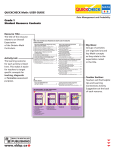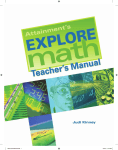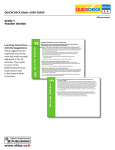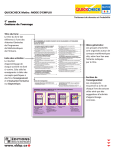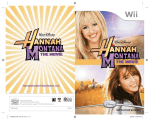Transcript
Quickcheck Math: user guide Data Management and Probability Grade 1 Teacher Section Learning Connection Activity Suggestions: These suggestions are organized around the same key math concepts addressed in the 24 activities. They relate to some of the Mathematical Process Expectations used in the Ontario Math Curriculum. 26 T E A C H E R S E C T I O N LEARNING CONNECTION ACTIVITY SUGGESTIONS Mathematical Process Expectations: Representing, Reasoning and Proving, Connecting Data can be organized into categories by sorting objects using one attribute Look at sorting objects from your class. Use the contents of the class recycling bin. Remove any sharp or unsafe items first. Then, using gloves, have small groups take turns sorting the contents using one attribute: colour, shape, size, texture. Or tell students to sort plastic from non-plastic recyclables. Which group has more? How do you know? Connect the results to your recycling habits as a class. What conclusions can you make? As a class would you like to change your behaviour? Set a goal. Sort the bin again in a month? Are you meeting your class goal? The same group of objects can be sorted in different ways Divide the class into three groups. Ask each group to choose a sorting rule and physically sort themselves. For fun, give them a time limit. When done, have them choose a different sorting rule to sort their group. For example, sort themselves by birthday month. Once each group has finished, have it present to the class. Can the class guess the sorting rules? Challenge: Can a group create a sorting rule that uses two attributes? Data can be organized and represented in pictographs and graphs Generate a question: Working in small groups / pairs have students think of something they would like to learn about their classmates. It could be their favourite flavour of ice cream; their favourite sport; their favourite animal. Make a chart: Have students select three or four options of favorites for their classmates to chose from and list them on the top of a chart mounted on a clipboard. Give each group a separate time to canvas their classmates’ opinions and record them on their chart. 1m70.indd int:51 T E A C H E R S E C T I O N 1m70.indd int:52 Make a concrete pictograph or graph: Using a grid prepared by the teacher on a white / blackboard, 23/04/09 18:32:14 Bristol board or chart paper, have each group organize their survey information. Groups can use sticky notes, construction paper, marker / chalk-shading, magnets or pictures to represent the number of responses for each choice. Have students put an appropriate title on their graph / pictograph. Communicate results: Using their graphs, have each group present its findings and conclusions to the class. Using number sentences and / or visual representations each group must give reasons for their interpretations. Read and interpret data in pictographs and graphs Ask a question: As a class, brainstorm questions you’d like answered that relate to your shared class experience: How much rain have we had this month? Do we need any new school supplies for the classroom? What gym equipment do we have? Choose one. Sort the data and record appropriate quantities of each set of data. Make a concrete representation: Using Bristol board or construction paper already prepared with a grid, have small groups make a concrete graph using connecting cubes — a different colour connecting cube tower for each group of data. Or try using a shower liner and hockey tape to make a large foldable grid. Students may use beanbags as representations on the grid. Describe data represented using comparative language: What conclusions can you make from the data on the graph / pictograph? Have students use comparative language to describe the differences between the quantities represented; e.g. “There were more bean bags than hoops but more hoops than hockey sticks.”Have students then quantify the difference; e.g. “We have ten more markers than pencils.”Students or groups of students then prove their statements in a concrete way using the connecting cubes / bean bags or other concrete manipulatives. Challenge: In partners use number sentences to show the difference between two categories. 23/04/09 18:32:14


